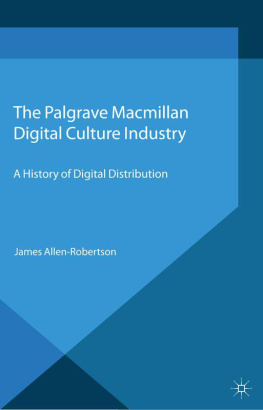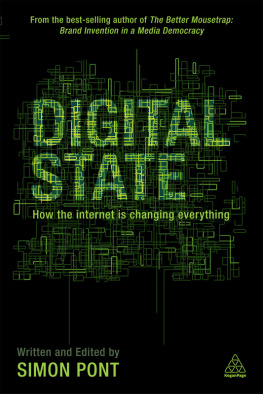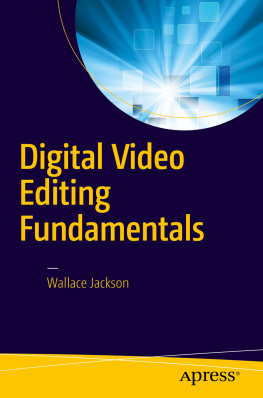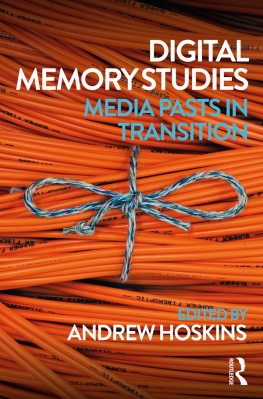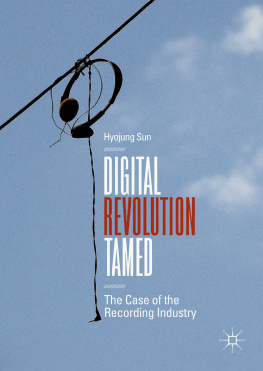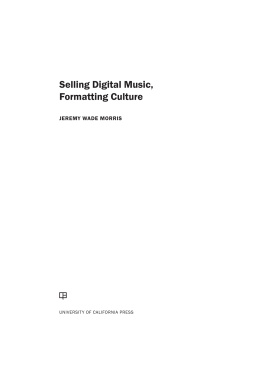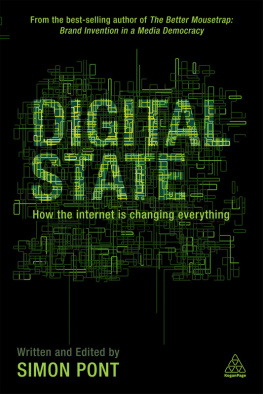Digital Culture Industry
Digital Culture Industry
A History of Digital Distribution
James Allen-Robertson


James Allen-Robertson 2013
All rights reserved. No reproduction, copy or transmission of this publication may be made without written permission.
No portion of this publication may be reproduced, copied or transmitted save with written permission or in accordance with the provisions of the Copyright, Designs and Patents Act 1988, or under the terms of any licence permitting limited copying issued by the Copyright Licensing Agency, Saffron House, 610 Kirby Street, London EC1N 8TS.
Any person who does any unauthorized act in relation to this publication may be liable to criminal prosecution and civil claims for damages.
The author has asserted his right to be identified as the author of this work in accordance with the Copyright, Designs and Patents Act 1988.
First published 2013 by
PALGRAVE MACMILLAN
Palgrave Macmillan in the UK is an imprint of Macmillan Publishers Limited, registered in England, company number 785998, of Houndmills, Basingstoke, Hampshire RG21 6XS.
Palgrave Macmillan in the US is a division of St Martins Press LLC,
175 Fifth Avenue, New York, NY 10010.
Palgrave Macmillan is the global academic imprint of the above companies and has companies and representatives throughout the world.
Palgrave and Macmillan are registered trademarks in the United States, the United Kingdom, Europe and other countries.
ISBN 9781137033468
This book is printed on paper suitable for recycling and made from fully managed and sustained forest sources. Logging, pulping and manufacturing processes are expected to conform to the environmental regulations of the country of origin.
A catalogue record for this book is available from the British Library.
A catalog record for this book is available from the Library of Congress.
Contents
and Napster: The Entrepreneurs of Risk
Figures
Acknowledgements
As the hacker ethic would have us believe, no work can be attributed to a single individual. It is certainly true in this case; though I am the only named author, this book was a community effort. I would like to thank Kate, my patient and supportive wife, whose handiwork can be seen in the figures throughout. I would like to thank Neil Renton for putting me on this path, as well as Professor Roger Burrows, Dr David Beer, Brian Loader and Dr Martin Dodge for their guidance and comments throughout. I thank Professor Samuelson at Berkley Law for answering my questions on the esoteric US copyright law. Finally, I thank the infinite population of bloggers, tweeters, commenters and archivers that produced and curated the huge archive of documents that made this work possible.
This work was supported by the Economic and Social Research Council (grant number ES/F03587X/1).
Glossary of Terms
AHRA | Audio Home Recording Act of 1992 |
AntiPiratbyrn | Swedish anti-piracy organisation |
ARG | Alternate Reality Game |
ASCAP | American Society of Composers, Authors and Publishers |
BBS | Bulletin Board System |
BDE | Brilliant Digital Entertainment |
BEN | BitTorrent Entertainment Network |
BMG | Bertelsmann Music Group |
Bootstrap | The self-sufficient process of connecting a new node to an existing network |
MPEG | Motion Picture Expert Group a specialist group within the International Standards Organisation |
RIAA | Recording Industry Association of America |
MPAA | Motion Picture Association of America |
DAB | Digital Audio Broadcasting a digital radio broadcasting standard, primarily used in Europe |
DAT | Digital Audio Tape a recordable medium similar to tape that utilised binary signal |
DHT | Distributed Hash Table a decentralised indexing service, useful for co-ordinating peer-to-peer networks (see also PEX) |
DMCA | Digital Millennium Copyright Act of 1998 |
DRM | Digital Rights Management |
EMI | Electric and Musical Industries Ltd |
EULA | End User Licence Agreement a form of private contract typically used in software between the rights holder and end user |
F/OSS | Free (and/or) Open Source Software |
IP | Intellectual Property |
ISO | International Standards Organisation |
JXTA | An open-source peer-to-peer protocol produced by Gene Kan |
P2P | Peer-to-Peer |
PEX | Peer-Exchange a decentralised system of indexing service useful for co-ordinating P2P networks (see also DHT) |
Piratbyrn | The Pirate Bureau a Swedish campaign group that sought IP reform |
PS3 | Sony PlayStation 3 console |
RAM | Random Access Memory a form of computer memory analogous to short-term memory in humans |
SCMS | Serial Copy Management System a copy-protection scheme intended to ensure that DAT tapes could be impeded from being replicated |
SDMI | Secure Digital Music Initiative a group of more than 200 companies that sought to develop an industry standard of digital rights management |
UCC2B | Article 2B of the US Uniform Commercial Code a provision of the code that sought to enforce the validity of private EULA contracts |
UCITA | Uniform Computer Information Transactions Act a continuation of the UCC2B campaign after the American Law Society withdrew its support |
VU | Vivendi Universal |
Warez | Copyrighted works traded without legal authorisation |
XCP | Extended Copyright Protection a scheme of DRM launched by Sony integrated into a selection of its CD catalogue |
YIPL | Youth International Party Line a zine circulated by the anarchic Youth International Party, which published proprietary Telco network data |
Introduction
The trial of the pirate kings
On 16 February 2009, four men stood accused of the promotion and facilitation of copyright infringement. The four defendants, Hans Fredrik Neij, Gottfrid Svartholm Warg, Peter Sunde and Carl Lundstrm were identified by the prosecution as the key agents that ran the Pirate Bay, an internationally infamous hub of media piracy. The plaintiffs, Warner Bros, MGM, EMI, Colombia Pictures, 20th Century Fox, Sony BMG and Universal, were demanding two years in jail for each defendant, as well as up to $180,000 in fines.
The trial lasted for little over three weeks; however, for that short period the Stockholm criminal court became a representational microcosm of the larger changes occurring in industrialised, informational societies. As events unfolded in the courtroom, a group of journalists live-blogged and Twittered from an adjacent room, whilst others inside and outside the court translated the courtrooms live audio feed from Swedish into a multitude of other languages. Automated Twitterbots collected all tweets related to the trial marked by the posters with the tag #spectrial and distributed them as a central feed for anyone who wished to follow the debate in real time.
Next page
